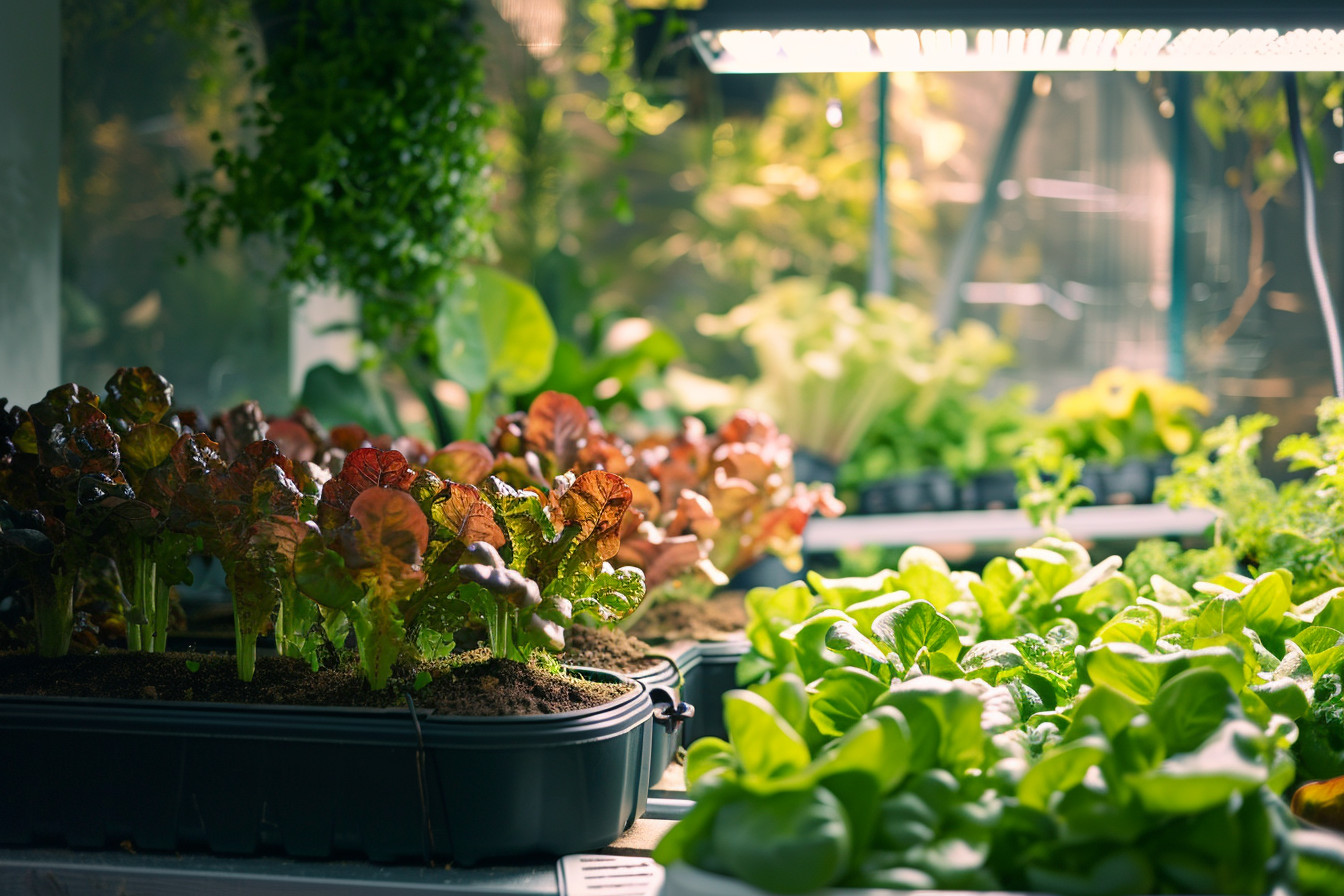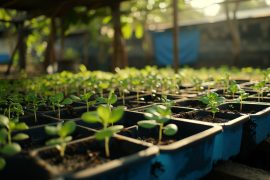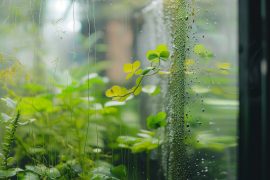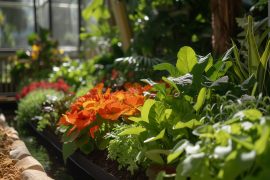I’ve always found a certain peace in the rhythmic flow of water and the whisper of plants in a garden. There’s something about combining fish with greens that takes me back to a simpler, more harmonious way of living. That’s what aquaponics does—it merges aquaculture and hydroponics into a closed-loop system that’s not just smart, but downright serene.
But why stop there? I’ve been tinkering with the idea of blending other sustainable practices into my aquaponics setup. Imagine harnessing rainwater, or integrating solar power to create a garden that’s as kind to the earth as it is to my soul. It’s like giving nature a high-five, and I’m here to share how you can do the same.
With each seedling and water pump, I’m convinced we’re onto something big. So let’s dive into the world of aquaponics and explore how it can be the cornerstone of a more sustainable, self-sufficient lifestyle. It’s not just gardening; it’s a revolution, one plant at a time.
The Serenity of Aquaponics
As I meander through the tranquil world of aquaponics, I’m struck by the sheer serenity it offers. The gentle hum of water circulating, the soft rustle of leaves, and the occasional splash from fish flitting beneath the surface—it’s almost meditative. But let’s dive deeper into the harmony this garden creates within my little ecosystem.
Aquaponics isn’t just smart; it’s a soothing symphony of life. From the nitrogen-fixing bacteria to the leafy greens reaching for the sky, every element works in a subtle yet profound dance. This harmony not only feeds my body with fresh produce but also feeds my soul with calm.
Let’s talk shop for a sec. For those who might not know, aquaponics intertwines aquaculture—raising fish—and hydroponics—growing plants in water. So, in a nutshell, fish waste fertilizes the plants, and the plants clean the water for the fish. Amazing, right?
But it’s not all about science and cycles; there’s history here, too. Did you know the Aztecs were some of the earliest adopters of aquaponics? They had these incredible floating gardens called chinampas. Though not identical to modern systems, they certainly laid the groundwork.
Onto the benefits—where do I start? This isn’t just a backyard project; it’s a lifestyle shift. First, there’s the obvious perk of year-round sustenance. But it’s the unseen effects that capture me—like the peace that comes from growing my own food and the satisfaction of caring for another form of life. And as for health, it’s a double-whammy. Not only am I eating healthier, but the very act of garden-tending is a form of stress relief and mental clarity.
Sharing personal experiences, I can’t express enough how mesmerizing it is to observe the interdependence of fish and plants. Just the other day, I noticed a few sprouts peeping up, their green shoots waving like tiny flags of victory. It was so understated, yet it represented the culmination of a well-maintained aquaponic ecosystem.
Blending Aquaponics with Sustainable Practices
When I look at my own aquaponics system bubbling away quietly in the corner of my garden, it strikes me how it’s not just a stand-alone setup. It’s a part of a bigger picture—an intricate tapestry of sustainable practices I’ve woven together over time.
But how does one go about mingling aquaponics with other eco-friendly habits? Well, it’s simpler than you might think. Take composting, for instance. While my fish provide most of the nutrients my plants crave, the added benefit of rich compost tea now and then gives that extra punch of goodness, making my greens even greener. And you know what? This nutrient-rich liquid waste from compost can be introduced into an aquaponic system with proper management.
Rainwater harvesting plays a fantastic duo with aquaponics too. Instead of using tap water, I collect rainwater to replenish my system which helps maintain a more natural pH balance—plus, it conserves water, a resource we all need to be mindful of.
Here are some cool numbers that really put it into perspective:
| Practice | Water Saved | Nutrient Boost | Energy Savings |
|---|---|---|---|
| Composting | Minimal | Yes | Low |
| Rainwater Harvest | Significant | Neutral | High |
| Solar Power | Neutral | Neutral | Very High |
And don’t get me started on solar power. By hooking up my pumps and aeration systems to my solar panels, I’m tapping into that big, fiery star’s energy, cutting down on electricity. It’s a game-changer.
My personal favorite blend is incorporating permaculture principles. The synergistic relationship between each component of my garden leads to a self-sustaining cycle. I’ve got flowering plants attracting pollinators and beneficial insects right next to my aquaponics setup, which not only boosts my plant’s growth but also creates a haven for wildlife.
What’s more, is that by choosing certain fish and plants, I can fine-tune this interdependence. Hardy fish like tilapia are great for beginners and tolerate a range of conditions, and when paired with veggies like lettuce or herbs like basil, you’ve got a match made in heaven.
- Composting: Reuse food scraps to make compost tea
- Rainwater harvesting: Save
Harnessing Rainwater for Your Aquaponics Setup
I’ve always found a special kind of serenity in the sound of rain – it’s like nature’s own symphony. And it turns out, this soothing element can play a crucial role in the health and sustainability of an aquaponics system. Rainwater, with its natural purity, is a gift that I’ve learned to utilize, and let me tell you, the benefits are more than just the calm it brings.
Incorporating rainwater harvesting into my aquaponics setup was a game-changer. Rainwater is typically soft water, which means it’s free from the minerals found in tap water that could disrupt the delicate balance of the system. It all starts with a Rain Catchment System, which can be as simple as a barrel that collects runoff from a roof. I’d encourage anyone who’s serious about sustainable gardening to consider this setup, and here’s why:
- It reduces the reliance on treated municipal water.
- Plants and Fish tend to thrive on the soft, quality rainwater.
- It can lower water bills since rain is, thankfully, free.
I’ve found that using a first flush diverter helps in keeping the rainwater clean, by discarding the initial rainfall which might carry impurities from the roof. It’s critical to ensure that your system is safe for both the fish and the plants.
Here’s a quick rundown of how to get started:
- Set up your gutters to direct rain into a collection barrel or tank.
- Install a first flush system to enhance water purity.
- Connect your collection system to your aquaponics setup.
Rainwater is not just beneficial for the plants. When I started using it, I noticed my fish were more active and seemed healthier. It made sense since rainwater mimics their natural environment. It’s slightly acidic, which is perfect for most aquaponic systems since it can help lower the pH, a common need in many systems.
But it’s not just about what’s good for the fish and plants. Every time I hear the trickling sound of rainwater as it’s being collected, I’m reminded of the harmony between my garden and the environment. It’s fulfilling to watch the natural precipitation become part of a cycle that feeds, grows, and sustains life in a closed-loop system that I’ve built with my own hands.
Integrating Solar Power into Your Aquaponics System
I’ve been soaking up all there is about harmoniously blending aquaponics with other sustainable practices. It’s not just a fad—it’s about crafting a self-sufficient, ecological narrative right in my backyard. Now, let’s dive into how you can pivot your aquaponics system towards energy independence by harnessing the sun’s power—my personal favorite chapter in this sun-kissed tale.
Solar panels: that’s where the journey begins. You see, aquaponic systems need pumps to circulate water and sometimes heaters to keep fish happy during those chilly nights. And guess what? Solar energy is perfect for that. By installing photovoltaic (PV) panels, you’re literally capturing a slice of the sun to power these critical components.
It’s pretty straightforward. The solar panels convert sunlight into electricity. This electricity can either be used in real-time or stored in batteries for when the sun decides to call it a day. That means the heartbeat of my aquaponics system—the water pump—keeps humming along, powered by the sun, ensuring that my plants and fish continue their symbiotic dance day and night.
And it’s not just about energy. Incorporating solar power into your setup is a tranquil nod to the cycles of nature. When the sun rises, it’s not just waking up my plants; it’s empowering my entire ecosystem to thrive. And nothing beats the serenity of watching sunrise reflections dance on my aquaponics setup, knowing it’s all running on clean, green energy.
In case you’re feeling anxious about the technical nitty-gritty, let’s keep it simple. The fundamentals include:
- Solar Panels: Capturing the sunlight.
- Charge Controller: Making sure batteries don’t overcharge.
- Batteries: Storing that sunny goodness.
- Inverter: Turning the sun’s bounty into something our pumps can use.
- Pumps and Heaters: Keeping fish and plants lively and well.
And here’s a real-life example to bring it all into the light. I’ve witnessed a friend’s setup where he used a modest array of panels to fuel both his water pump and air stones, ensuring his plants were getting all the nutrients delivered in just the right doses.
Aquaponics: A Cornerstone of Sustainability
As I look out onto my garden, filled with the gentle bubbling of water and the serene green of plants, there’s a sense of deep connection to the earth. It’s here, in the tranquility of my aquaponics setup, that I can’t help but marvel at how this system is a true cornerstone of sustainability. Aquaponics combines aquaculture with hydroponics, creating a closed-loop ecosystem where fish and plants thrive together. I remember standing beside my system for the first time, realizing the untapped potential within.
My garden isn’t just a space for cultivation; it’s a hub for sustainable living. By integrating vertical gardening, I’ve watched sprouts claim their vertical space, reaching high to soak up the sun. I have seen firsthand how vertical gardening increases yield per square foot, and I’ve got to tell you, picking fresh tomatoes while barely having to bend over is quite a splendid thing.
As a gardener, I’ve always valued educational experiences as much as the harvest. I find joy in discussing the history of gardening movements, and aquaponics is a culmination of centuries of agricultural evolution. It stands on the shoulders of inventions like the hanging gardens of Babylon and the floating gardens of the Aztecs. Bringing those ancient methods into the modern era, aquaponics not only pays homage to the past but also paves the way for the future of sustainable food production.
In an aquaponic system, Nitrate-rich water from fish waste nourishes plants, which in turn purify the water returning to the fish. It’s a symbiotic relationship that cuts the need for chemical fertilizers. Here’s something neat: you can actually watch the roots absorbing nutrients directly from the water. It’s like giving your plant a superfood smoothie, and boy do they love it!
I’ve helped friends set up their systems and the most frequently asked question is, “Is this complicated?” Well, the answer is no. The technicalities can be simplified. Think of the fish as little aquatic gardeners who feed your plants while they swim. The plants, acting like living filters, clean the water. A pump circulates the water between them, and voilà, you’ve got yourself an aquaponics system.
Revolutionizing Gardening, One Plant at a Time
There’s something undeniably peaceful about being among plants, where the only soundtrack is the hum of nature. I’ve always found this tranquility while working in my garden. My hands in the dirt, I am rooted in the moment. I’m not just growing plants; I’m cultivating a serene escape from the hustle and bustle.
In my quiet corner of the world, I’ve embraced various gardening techniques that align with sustainable living. Companion planting is one of those—a practice as old as agriculture itself. Imagine planting tomatoes alongside basil; they’re not just neighbors, they’re allies in growth. Basil repels pests that would otherwise feast on the tomatoes, exemplifying plant symbiosis.
Let’s not forget about vertical gardening—it isn’t only a space-saver but a visual treat. I recall reading about the hanging gardens of Babylon, and now, we’re improvising with wall planters and trellises in urban spaces. It’s a contemporary twist on an ancient marvel, a lush tapestry of greenery that ascends skyward, defying gravity and greening our cities.
I often reflect on the fact that there’s an educational dimension to all this. I’ve learned that through teaching gardening, we impart lessons on patience, responsibility, and the circle of life. And it does wonders for mental wellness. It turns out that getting your daily dose of vitamin D and phytoncides—those are the natural oils found in plants that reduce stress—is just what the doctor ordered.
Translating the technical terms of gardening can be tricky, but I like to think of it this way: a garden’s ecosystem is a living puzzle, and each piece plays a vital role. The soil is the foundation, teeming with organisms that transform decay into nutrients. Aquaponics, then, is like a closed-loop puzzle where fish and plants solve mutual challenges—the fish provide the fertilizer and the plants clean the water. It’s nature’s ingenuity at its finest.
Final Thought
I’ve gotta say, diving into aquaponics has been a real eye-opener. It’s not just about growing food sustainably; it’s a lifestyle change that hooks you with its simplicity and efficiency. By marrying aquaponics with other eco-friendly practices, I’m convinced we’re onto something big. We’re not just farming smarter; we’re paving the way for a greener future, one cycle at a time. And hey, if it means getting a bit of mental peace and some tasty veggies along the way, I’m all in. Here’s to creating our own little ecosystems and watching them thrive!









